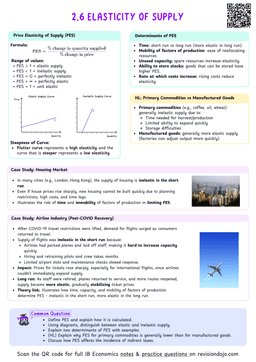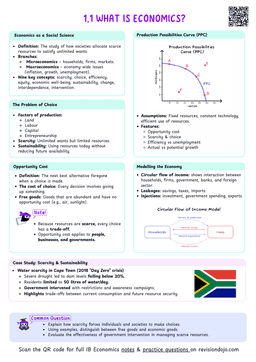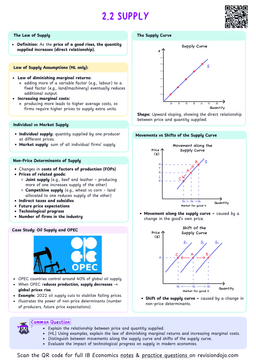In Section 2.4.3, we introduced the idea that the main goal of firms is profit maximisation:
- At its core, profit maximisation is about finding the level of output where a firm earns the highest possible profit.
- This happens when a firm compares its revenues and costs and adjusts its output accordingly.
We will also discover there are three types of profits firms can have:
- Normal profit.
- Abnormal profit.
- Losses (negative profit).
Total profit = Total revenue - Total costs
Total revenue (TR)
Revenue
The money earned by a firm, over a period of time, from selling goods and services.
Total revenue (TR) is the total amount of money earned by a firm in a period of time. It is found by using the following formula:
$$TR= P \times Q$$
where:
- $P$ = Price of the good or service.
- $Q$ = Quantity of goods (or services) sold.
Total costs (TC)
Total costs (TC) is the total expenditure incurred by a firm in the production of goods or services over a given period. It is calculated using the following formula:
$$TC=TFC+TVC$$
where:
- $TFC$ = Total Fixed Costs: costs that do not change with output (rent, salaries...)
- $TVC$ = Total Variable Costs: costs that change with output (raw materials, shipping...)
Total profit (TP)
Profit
The money left for a firm after the total costs have been subtracted from total revenue.
Total profit (TP) is the total financial gain a firm makes after deducting total costs (TC) from total revenue (TR). It is calculated using the following formula:
$$TP=TR−TC$$
where:
- $TR$ = Total Revenue
- $TC$ = Total Costs
A positive profit means the firm is making money, while a negative profit (loss) means the firm is spending more than it earns.
Marginal revenue (MR) = Marginal cost (MC)
Marginal revenue (MR)
Marginal revenue (MR) is the additional revenue earned from selling one more unit of output. It can be expressed by the following formula:
$$MR = \frac{\Delta TR}{\Delta Q}$$
where:
- $\Delta TR = \text{New } TR - \text{Old } TR = \text{Change in } TR$.
- $\Delta Q = \text{New } Q \text{ sold } - \text{Old } Q \text{ sold } = \text{Change in } Q \text{sold }$.
The marginal revenue curve
If the price at which a firm sells its good remains constant, regardless of its price:
- The marginal revenue is always the same.
- The marginal revenue equals the price.
- This can be seen in Table 1 below.
| Price | Quantity sold | Total revenue | Marginal revenue |
|---|---|---|---|
| 20 | 1 | 20 | 20 |
| 20 | 2 | 40 | 20 |
| 20 | 3 | 60 | 20 |
| 20 | 4 | 80 | 20 |
| 20 | 5 | 100 | 20 |
However, if the firm increase its prices as quantities sold increase (as dictated by the supply curve):
- The marginal revenue decreases as quantity sold increases, eventually becoming negative.
- The marginal revenue is not equal to the price.
- This can be seen in Table 2 below.
| Price | Quantity sold | Total revenue | Marginal revenue |
|---|---|---|---|
| 20 | 5 | 100 | 40 |
| 30 | 4 | 120 | 20 |
| 40 | 3 | 120 | 0 |
| 50 | 2 | 100 | -20 |
| 60 | 1 | 60 | -40 |
- In Table 2 above, as the price decreases, the quantity of output increases, demonstrating the law of demand.
- This pattern occurs when a firm is operating in an imperfectly competitive market.
- In such markets, firms must lower their price to sell more units, and so it follows the law of demand.
- We will learn more about imperfectly competitive markets in coming sections.
Therefore, if we plot the relationship between marginal revenue, price, and quantity produced (sold), then we have two different graphs (Figure 1):
Exam techniqueNote that the Y axis represents marginal revenue (MR) and price (P) at the same time. This is because both quantities are expressed in currency.
Marginal cost (MC)
Marginal cost (MC) is the additional cost incurred from producing one more unit of output. It can be calculated through the following formula:
$$MC = \frac{\Delta TC}{\Delta Q}$$
where:
- $\Delta TC = \text{New } TC - \text{Old } TC = \text{ Change in } TC$.
- $\Delta Q = \text{New } Q \text{ sold } - \text{Old } Q \text{ sold }= \text{Change in } Q \text{ sold}$.
The marginal cost curve
As we saw in Subtopic 2.1.1, marginal costs increase as the quantity produced increases. This was due to:
- Inefficiencies: as explained earlier, adding more variable inputs leads to less efficient production.
- For every additional unit of output there is more input (higher costs).
- As seen by the law of diminishing marginal returns, for every additional unit of output lesser marginal product (lower return).
- Therefore, the cost per each additional unit of output increases.
- Scarcity of efficient resources: expanding production often requires using less efficient resources.
- For example, a factory might need to pay higher, overtime wages or use older, less efficient machinery to meet higher production targets.
Imagine you run a pizza restaurant, and the cost of hiring a worker is USD $12$ (Table 3).
| Number of Workers | Total Pizzas Produced | Pizzas Produced by New Worker (Marginal Product) | Cost to Hire New Worker (USD) | Marginal Cost of Each Additional Pizza (USD) |
|---|---|---|---|---|
| 1 | 3 | 3 | 12 | 4 |
| 2 | 7 | 4 | 12 | 3 |
| 3 | 10 | 3 | 12 | 4 |
| 4 | 12 | 2 | 12 | 6 |
| 5 | 13 | 1 | 12 | 12 |
- Initially, you paid USD $12$ to hire $1$ worker, and this gave you an output of $3$ pizzas.
- This means that it initially costs USD $12$ to make 3 pizzas, so on average a pizza cost USD $4$
- This can be thought of as the Marginal Cost of a Pizza in the beginning (when you have no workers)
Now you decide to hire a second worker:
- The second worker also costs you USD $12$ but they increase the number of pizzas by $4$.
- Hence on average, each extra pizza the second worker brought cost you only USD $3$ dollars
- These USD $3$ are therefore the new Marginal Cost (when producing $7$ pizzas).
Then, you decide to hire a third worker:
- The third worker also costs you USD $12$ but the pizza production only increases by $3$.
- Hence on average, each extra pizza the second worker brought cost you only USD $4$ dollars.
- These USD $4$ are therefore the new Marginal Cost (when producing $10$ pizzas).
- And so, the Marginal Cost have begun to increase with output.
Eventually, when you already have $4$ workers and you to hire the fifth worker:
- The cost of the extra (fifth) worker is still $12$ dollars.
- However, the number of pizzas extras pizzas made only increases by $1$.
- This means the Marginal Cost of the 13th pizza produced has increased to $12$ dollars.
Therefore, if we plot the relationship between marginal cost (MC) and quantity produced (sold) in Table 3, we obtain the marginal cost (MC) curve (Figure 2):
TipUnlike marginal revenue (MR), all firms, regardless of whether they increase their quantity produced as prices increase or not, have increasing marginal cost (MC).
Firms maximising profits at MR = MC
All firms, regardless whether their selling price is constant or varying, maximise profits when their marginal revenue equals their marginal cost. This is because:
- If firms produce at a price and quantity where MR > MC:
- Producing more increases profit because additional revenue is greater than additional costs.
- Therefore, firms will increase output to take advantage of extra profit opportunities.
- Contrarily, if firms produce at a price and quantity where MR < MC:
- Producing more reduces profit because additional costs are greater than additional revenue.
- Therefore, firms will reduce output to avoid making losses.
- However, if firms produce at a price and quantity where MR = MC:
- This is the profit-maximising level of production.
- Producing more or less would reduce profit.
- Firms have no incentive to change their output.
Normal profit (AR = AC)
Average revenue (AR)
Average revenue (AR) is the revenue a firm earns per unit of output sold.
$$AR = \frac{TR}{Q}$$
where:
- $TR$ = Total revenue
- $Q$ = Quantity of output sold
The average revenue curve
If the price at which a firm sells its good remains constant, regardless of its price:
- The average revenue is always the same.
- The average revenue equals the price.
- This can be seen in Table 4 below.
| Price | Quantity sold | Total revenue | Marginal revenue | Average revenue |
|---|---|---|---|---|
| 20 | 1 | 20 | 20 | 20 |
| 20 | 2 | 40 | 20 | 20 |
| 20 | 3 | 60 | 20 | 20 |
| 20 | 4 | 80 | 20 | 20 |
| 20 | 5 | 100 | 20 | 20 |
However, if firm increase their prices as quantities sold increase (as dictated by the supply curve):
- The average revenue decreases as quantity sold increases.
- However, the average revenue is still equal to the price.
- This can be seen in Table 5 below.
| Quantity produced | Price | Total revenue | Marginal revenue | Average revenue |
|---|---|---|---|---|
| 1 | 60 | 60 | 60 | 60 |
| 2 | 50 | 100 | 40 | 50 |
| 3 | 40 | 120 | 20 | 40 |
| 4 | 30 | 120 | 0 | 30 |
| 5 | 20 | 100 | -20 | 20 |
Therefore, if we plot the relationship between average revenue, marginal revenue, price, and quantity produced (sold), then we have two different graphs (Figure 3):
Exam techniqueNote that the Y axis represents average revenue (AR), marginal revenue (MR) and price (P) at the same time. This is because both quantities are expressed in currency.
Average costs
Average cost (AC) is the total cost per unit of output produced.
$$AC = \frac{TC}{Q}$$
where:
- $TC$ = Total Cost
- $Q$ = Quantity of output produced
If we add average cost (AC) to our pizza example from above (Table 3), we can see the relationship between quantity produced and AC (Table 6):
| Number of Workers | Total Pizzas Produced | Cost to Hire New Worker (USD) | Marginal Cost of Each Additional Pizza (USD) | Total Cost | Average cost |
|---|---|---|---|---|---|
| 1 | 3 | 12 | 4 | 12 | 4 |
| 2 | 7 | 12 | 3 | 24 | 3.43 |
| 3 | 10 | 12 | 4 | 36 | 3.6 |
| 4 | 12 | 12 | 6 | 48 | 4 |
| 5 | 13 | 12 | 12 | 60 | 4.62 |
The relationship between marginal cost, average cost, and quantity produced, and AC can be observed in Figure 4:
Exam techniqueNotice how the MC curve intersects the AC curve at its lowest point. When drawing diagram, this is important.
Normal profit at AR = AC
Normal profit
When a firm’s total revenue exactly covers total costs. It is the minimum level of profit that the firm needs to earn in order to remain in the market in long term.
Normal profit occurs when a firm’s total revenue exactly covers total costs. Expressed as a formula, normal profit occurs when:
$$AR = AC$$
When a firm is making normal profit:
- The firm is self-sustaining but not growing.
- It occurs at the break-even point, where AR = AC.
Normal profit is also called zero profit because firms are left with no spare revenue.
ExampleA bakery sells 1,000 loaves of bread at $5 each.
- Total Revenue (TR) = $5 × 1,000 = $5,000
- Total Cost (TC) = $5,000
- Since TR = TC, the bakery earns normal profit.
Students often confuse the meaning of normal (zero) profit. They wonder:
- How can a firm run with zero profits?
- How is the owner of the firm going to get paid?
The mistake here is to assume that the wage of the owner of the firm is not included in the costs.
Abnormal profits (AR > AC)
Abnormal profit
When a firm's average revenue is greater than its average costs.
Abnormal profit occurs when a firm’s total revenue exceeds total costs. Expressed as a formula, abnormal profit occurs when:
$$AR>AC$$
This means:
- Total Revenue (TR) > Total Cost (TC)
- The firm earns extra profit beyond covering costs.
A tech company sells smartphones for $1,000 each.
- Total Revenue (TR) = $1,000 × 10,000 = $10,000,000
- Total Cost (TC) = $7,000,000
- Profit = TR - TC = $3,000,000
Think of abnormal profit as the exception to the rule. Usually, firms use all their spare revenue to produce more. For this reason having a positive profit is an exception to the rule.
Losses (AR < AC)
A firm makes a loss when its total revenue is less than total costs.
$$AR<AC$$
This means:
- Total Revenue (TR) < Total Cost (TC)
- The firm is spending more than it earns.
A clothing store sells 5,000 shirts at $20 each.
- Total Revenue (TR) = $20 × 5,000 = $100,000
- Total Cost (TC) = $120,000
- Loss = TR - TC = -$20,000
Firms never operate in a loss in the long-run. They either cut costs, increase their revenue, or close.


